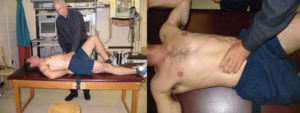Core stability: “Fascial raking” to stimulate abdominal wall activation for ultimate performance Stuart McGill, Professor of Spine Biomechanics
(Download PDF, 57Kb)
Core stability depends on activity in the many muscles that act around the torso, and in particular those that form the abdominal wall. This article describes how to improve the contraction quality of these muscles to enhance performance – even in accomplished athletes.
Measuring stability is difficult but those few labs around the world that have measured core stability, or spine stability, have concluded that all muscles are necessary contributors. This is because the spine is a flexible rod yet it must be able to bear compressive loads. It will buckle without a very robust guy wire system formed by the many muscles. Furthermore, when all muscles contract together they create a “superstiffness” that is higher than the sum of the stiffnesses of the individual muscles. Consider the architecture of the abdominal wall. Stability comes from a symmetric stiffness developed by the muscles around the spine. Activating just one abdominal muscle would create just one source of stiffness but would also result in an interruption of the force linkage. Consider that the entire abdominal wall has its anterior connection to the rectus abdominis muscle. The forces in the oblique muscles are directed to the rectus and its sheath, and then transferred to the rib cage and pelvis to enhance torque production and stability. As the three layers of the abdominal wall contract, a superstiffness is created to enhance stability. Teaching activation of the entire abdominal wall to patients and to performance athletes alike, is important.
Thus, the task is to facilitate contraction of the abdominal wall. Many therapy techniques employ a light manual “brushing” over the muscle to stimulate contraction. But this is generally for low level contractions and for superficial muscles. The challenge is to produce a robust activation of the entire abdominal wall for the purposes of both training and for ensuring sufficient stability needed during demanding tasks.
We have learned many things from our work with intramuscular electrodes that have to be implanted in the abdominal wall to monitor deep muscle activity. A valuable discovery involved the muscle activation facilitation mechanism. For example, as the canula (large bore needle) penetrates the skin in the abdominal region and touches the fascia of the oblique muscles, it creates a characteristic pain. The pain can be reproduced by taking a long fingernail, digging it into the oblique muscle and “raked”. This produces a pain that can be referred to as “scratchy”. Typically it causes the individual to respond by contracting the muscle wall.
To encourage complete activation of the abdominal wall, have the individual lie on their back. Prepare by having them place their hands under the lumbar region to prevent the spine from flattening to the floor (this results in spine flexion and an increase in the risk of injury – don’t allow it to happen). Instruct them to contract the abdominal wall. Facilitate this by taking your hand with a wide grip, placing the thumb lateral to the rectus abdominis and the fingertips lateral to the other rectus – you are gripping into the oblique muscles (Figure 1). Do not grip the rectus abdominis. Now instruct them to initiate a slight flexion motion with the locus of rotation in the middle of the sternum (not in the lumbar spine). The head, neck and shoulders hardly move. Now “rake” the abdominal with the instruction “fight me with your abdominal wall”, “contract”. Irritate the obliques by squeezing your thumb towards your fingertips. Encourage good effort while you are stimulating the abdominal wall.
This procedure trains the abdominal wall for short range stiffness enhancement and forms the foundation for eventual plyometric training of the abdominal wall to enhance performance. Try the technique during other tasks. For example, even accomplished athletes will report instant performance enhancement on tasks such as pull-ups with simultaneous fascial raking. More information about this component of training can be found in my book “Ultimate Back Fitness and Performance”.

Figure 1. With the individual voluntarily contracting their abdominal wall, facilitate more complete contraction by “raking” the fascia over the obliques. Make sure that your fingers are lateral to the rectus abdominis.
About the Author
Stuart McGill is a Professor of Spine Biomechanics and is the Chair of the Department of Kinesiology at the University of Waterloo in Canada. He has been the author of over 200 scientific journal papers that address the issues of low back function, injury prevention and rehabilitation, and performance training. Collectively this work has received numerous scientific awards. He sits on the editorial boards of the journals SPINE, Clinical Biomechanics, and Journal of Applied Biomechanics. As a consultant, he has provided expertise on assessment and reduction of the risk of low back injury to various government agencies, many corporations and legal firms and professional/international athletes and teams from many countries. In addition to seeing patients sent for consult, he teaches clinical courses regularly around the world. His other textbook was entitled “LowBack Disorders: Evidence Based Prevention and Rehabilitation” published by Human Kinetics.

